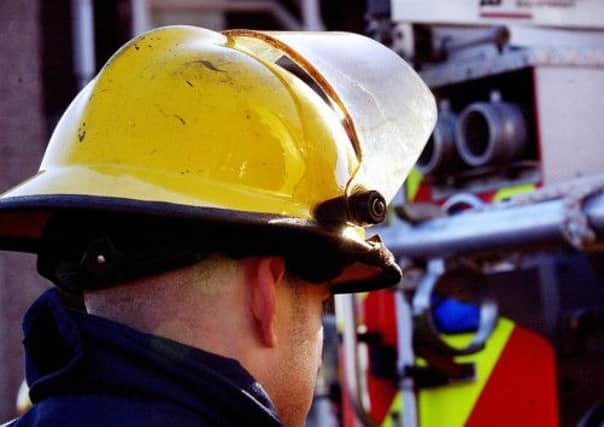Report reveals shortage of Highland firefighters


Critics fear the lack of new recruits is putting pressure on the current crop of part-time firefighters.
Union chiefs have called for a major recruitment drive in a bid to cut the chances of a retained station being unavailable for a potential life-saving emergency.
Advertisement
Hide AdAdvertisement
Hide AdJohn Duffy, Scotttish Secretary for the Fire Brigades Union, said more part-timers were working outwith the areas they are retained, making it more difficult for a full crew to be available during the day.
A Performance Report for the Highland area of the Scottish Fire and Rescue Service classifies the availability of retained crews in the red category, meaning “below standard”.
The figures show that from 1 July to 30 September, the availability of stations fell to 87.6 per cent compared to 91.3 per cent in the same period last year.
The report to Highland Council outlines how staffing shortages are a major factor for the decline.
It reveals the Inverness, Nairn, Badenoch and Strathspey area should have 320 retained firefighters, but has just 119.
Caithness, Sutherland, Ross and Cromarty should have 356, but has only 288, while Lochaber, Skye and Lochalsh is intended to have 196 retained firefighters, but falls short with 161.
Mr Duffy said the shortage makes it increasingly difficult for current part-time personnel with other full-time jobs to crew their appliances around the clock.
The report compiled by the fire service states: “We use a Retained Availability system for staff who work on the Retained Duty System (RDS) to record when station staff are off-call, and how this affects the availability of the station’s fire appliances.
Advertisement
Hide AdAdvertisement
Hide Ad“The availability of stations in the Highland area this quarter decreased to 87.6 per cent in comparison to 90.7 per cent in the previous quarter [and 91.3 per cent for the same quarter last year].
“As availability is lower than the average, we classify this Key Performance Indicator as red.
“We recognise the challenges staff face of combining primary employment and RDS operational cover across the communities in the Highland area.”
Retained crews provide the majority of fire cover in the Highlands, with only Inverness having a full-time station.
Mr Duffy said: “The service needs to get out and recruit more people. It’s as simple as that. The budget for retained firefighters is there but for some reason they are not getting enough people in to fill the roles.
“In the past, people worked in the area they lived in, making it easier for them to respond to a call-out.
“Often we are finding there are more people commuting to towns and cities as opposed to working in the areas they live, meaning even if there is a station with a full complement of retained staff, they are often not available because they are physically not in the area.”
Labour councillor for Inverness Ness-side - and former firefighter Fraser Parr – has accused the new single force of “ignoring” the Highlands.
Advertisement
Hide AdAdvertisement
Hide AdHe said: “Before, I thought the Highlands and Islands had been left on a limb as far as the fire service was concerned, but now it seems we have been completely forgotten.
“In my opinion the new service is being run from a central belt perspective with little understanding of how things work up here, which is 99 per cent retained.
“The feedback I am getting from personnel in the service is that the good work that was being done to improve the service in the area has gone to waste. I cannot see it improving unless the single board introduces the extra measures that were promised before it came into effect.”
Highlands and Islands Conservative MSP Mary Scanlon was shocked by the statistics, blaming the introduction of the single Scottish Fire and Rescue Service for the crisis.
“People across Scotland were given assurances that we would have a consistent level of fire and rescue service that would be well managed and resources would be given to training, personnel and infrastructure,” she said. “It is very disappointing that months into the new service things seem to be deteriorating rather than improving.
“This may tick the box of financial savings but what we need most of all is a quality service that people can depend on. This is not good enough.”
Local senior fire officer Scott Hay said: “The Scottish Fire & Rescue Service actively encourages not only members of the public, but also employers in our rural communities to contact us or come along to any recruitment event in their area, to get more information on what our needs are within each community.
“The structure of the Scottish Fire and Rescue Service has allowed the creation of the Local Senior Officer role, supported by a network of locally based senior managers who are responsible for supporting recruitment activities within their local community fire stations.
Advertisement
Hide AdAdvertisement
Hide Ad“Examples of this include engaging with local councillors and elected members, station open days, recruitment fairs and adverts in local newspapers/media. Local recruitment will also focus on areas of high footfall such as local supermarkets and shopping centres.
“The service routinely recruits members from the local community. Fire and rescue services UK wide recognise the challenges faced by RDS staff in terms of combining their retained duties with their primary employment.
“The service depends on the commitment of retained firefighters, who cover some of the most remote and rural areas of Scotland.”